Support strong Canadian climate journalism for 2025
Decades of failing to cut emissions are saddling Canadians with ever-steeper climate targets.
By dragging our feet, we've increased the amount of emissions we need to cut while shrinking the time we have remaining to do it. As the world races to net-zero in 2050, the penalty Canadians are paying for foot-dragging is piling up fast.
To illustrate the increasingly deep hole we've dug for ourselves, I've created two charts. With the first, we'll look at Canada's history of ever-rising emissions and the ever-steepening climate targets that have come with it. And with the second chart, we'll compare the diverging paths to net-zero taken by Canada and one of our Commonwealth peers, the United Kingdom. We used to be side-by-side with them. As you'll see, the U.K. steadily cut emissions while we let ours rise. The U.K.'s actions are paying big dividends for them now, while our inaction is making our path ahead increasingly difficult.
Canada's steepening climate targets
This first chart shows how Canada's climate targets keep getting steeper. Each target is represented by a downward bar. These bars show how many millions of tonnes of CO2 (MtCO2) needed to be cut every year if we were to meet that target. The year shown above each bar is the year in which each target was pledged.
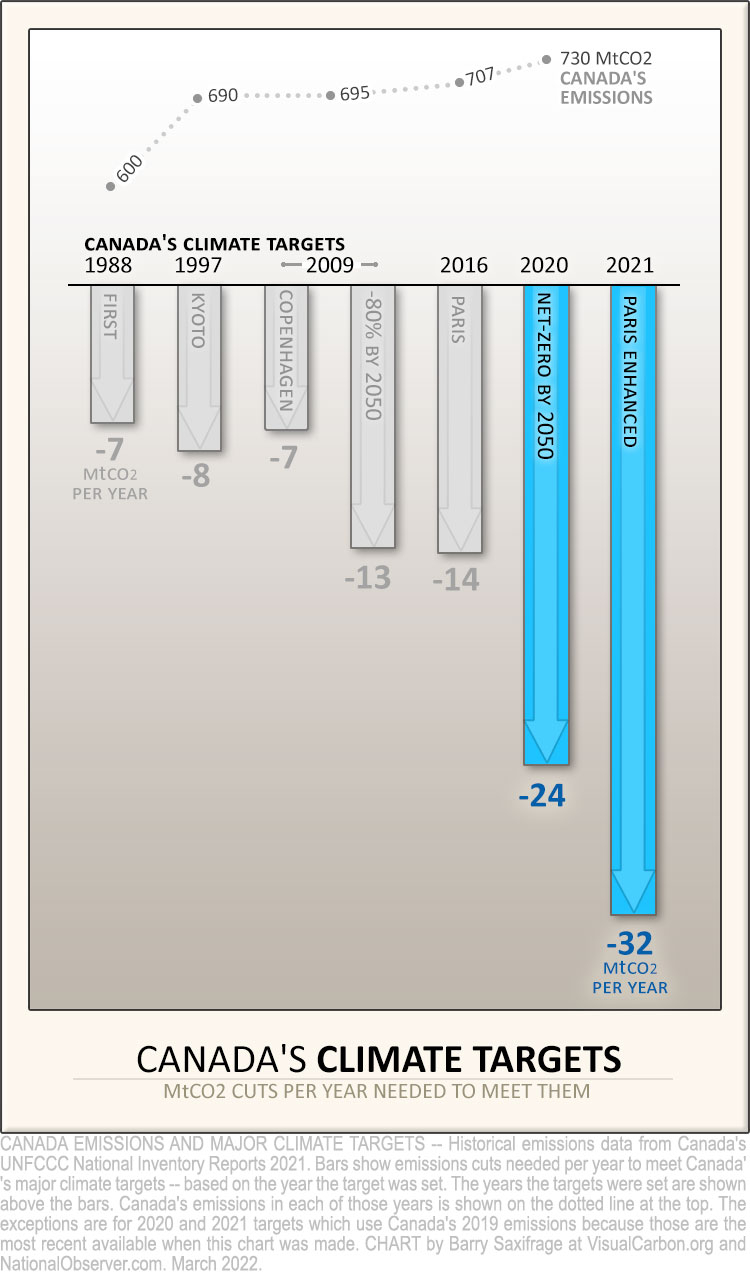
For example, Canada's first target was set in 1988 and required cuts of 7 MtCO2 each year.
Back then, Canada emitted around 600 MtCO2 a year. You can see how much Canada was emitting as each target was pledged by looking at the dotted line at the top of the chart.
Notice how every time Canada needed to pledge a new climate target, we were emitting more than when we set the previous target.
Unsurprisingly, increasing the pile of emissions while shrinking the time to act leads to steeper targets.
A good example of this can be seen in the targets set by the Harper government. Back in 2009, it set a Copenhagen Accord target that required cuts of 7 MtCO2 each year. Instead of cutting emissions that much each year, Canada increased them. Several years later when the Harper government needed to propose a new target under the Paris Agreement, it had to double the rate — to 14 MtCO2 each year.
Again, Canada didn't follow through and instead let climate pollution rise to 730 MtCO2 in 2019 (the most recent year of data available).
The Trudeau government recently joined our global peers in pledging to hit net-zero by 2050. We now need to cut 24 MtCO2 each year to get there. As we will see next, these are much larger cuts each year than we would be facing if we had not dragged our feet for so long.
The U.K. shows our path not taken
This second chart shows this clearly in the diverging paths taken by the U.K. and Canada.
I've chosen the U.K. for comparison because back in 2002, both nations emitted the same amount — around 705 MtCO2. That's shown by the red dot in the upper left of the chart.
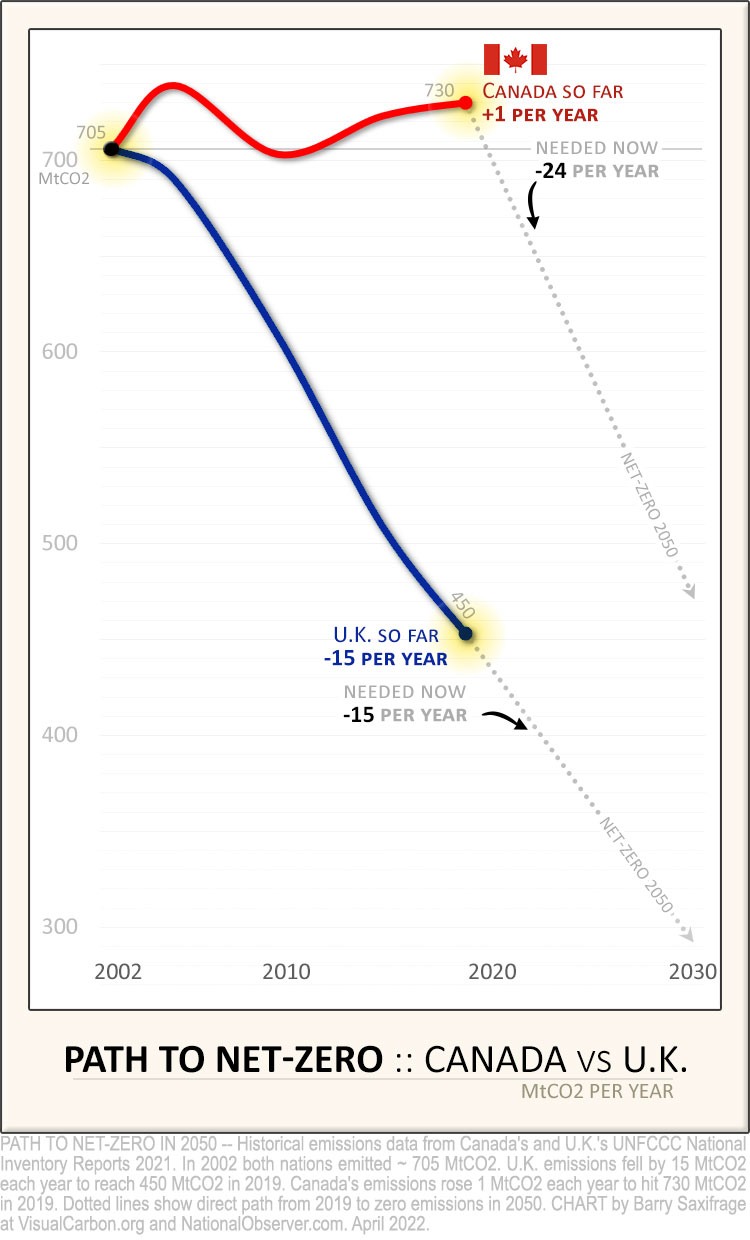
Back then, both nations had the same pathway to net-zero emissions in 2050 — cutting emissions 15 MtCO2 per year.
As the blue line shows, the U.K. followed that path. It enacted strong climate policies that steadily cut its emissions in line with what was needed. Now it only needs to continue on at the same pace.
As the red line shows, Canada did the opposite by increasing emissions. That's forced our path to net-zero in 2050 to become steeper and steeper.
For example, by 2010, the cuts we needed to make had grown 20 per cent to reach 18 MtCO2 per year.
By 2015, they were 40 per cent larger, at 21 MtCO2 per year.
By 2019, they were 60 per cent larger, at 24 MtCO2 per year.
And if our emissions are just as high in 2025, our required cuts will rise again to hit 28 MtCO2 per year. That's twice as much each year than if we had stayed in step with the U.K.
The U.K. has gained two big dividends by steadily cutting its climate pollution. The first payoff, as shown above, is that its remaining cuts are now much smaller than ours each year. The second bonus is that it already has a tested set of policies in place delivering the kinds of cuts needed. As the chart shows, the U.K. has a straight-line path to 2050. Keep calm, carry on.
Compare the U.K.'s path to what Canada now faces. We need to dramatically change direction, and quickly. Our existing hodgepodge of weak policies has plunged us into ever-deeper trouble. Now we face the double burden of having to make much larger cuts each year, while also developing a new set of climate policies and expertise that will allow us to do that.
Hey, here's a crazy idea. How about the Canadian government immediately adopts the policies that have worked so well for the U.K.? Right now. This year.
We could start by adopting its powerful Carbon Budget Law. It empowers an independent commission to develop all the needed policies to meet the targets. The government is required by law to stay on the path to net-zero by 2050 by meeting carbon budgets that cover all emissions in every year, starting immediately with the year it is enacted. And the government must enact all the policies to meet each carbon budget many years in advance to give citizens and businesses a long lead time to transition.
The U.K. passed this law way back in 2008. We'd certainly be late to the party, but at least we'd have something to celebrate in Canada, for a change.
As the chart above clearly illustrates, our decades of foot-dragging come with real costs to Canadians. These costs are piling up rapidly. If we had joined the U.K. on climate action back in 2002, Canadians would have a much easier task today. The longer we delay in enacting effective climate policies, the harder it will be for us.
*******
Endnotes:
PER CAPITA EMISSIONS
The U.K. has a larger economy and bigger population than Canada. So even when our national emissions were the same back in 2002, the British emitted half as much per capita as we were. Despite having much lower emissions per person, they still managed to make big cuts to their overall emissions. At this point, the British emit only one-third as much per capita as Canadians: 7 tonnes of CO2 (tCO2) vs 20 tCO2 for us.
FOOT-DRAGGING AND THE PARIS TARGETS
Canada's penalty for foot-dragging also shows up in our Paris Agreement targets. The discussion of this is a bit longer and more detailed, so I've put it here in the endnotes for those interested.
I've also added an extra chart to help illustrate it. This chart shows the emission history since 1990 for the Group of Seven (G7) nations, which includes the European Union (EU) as well.
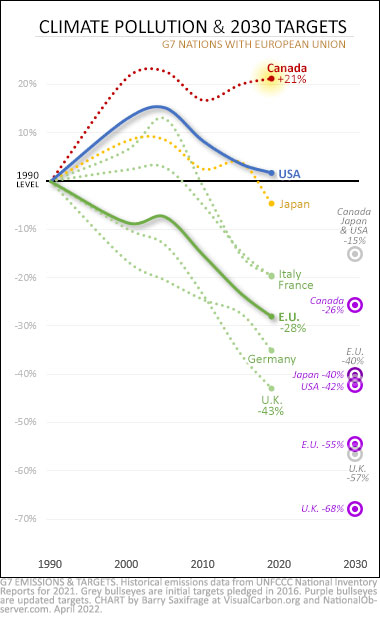
Initial targets for 2030 are shown on the chart as grey bull's eyes with grey text. Canada's initial target was proposed by the Harper government and later formally submitted by the Trudeau government. It worked out to 15 per cent below 1990 levels by 2030. As you can see, that matched the targets from the U.S. and Japan at the time. To meet this initial target, Canada needed to cut 14 MtCO2 each year starting in the pledge year.
Those initial targets were too weak to stave off a full-blown climate crisis. So, last year, all the G7 nations enhanced their targets. These new targets are shown in purple on the chart.
Canada's new target worked out to 26 per cent below 1990 levels. To get there, we now need to cut an eye-watering 32 MtCO2 each year. That's obviously far more than the 14 MtCO2 per year required when we set our first target.
Notice, however, that our new target is now far behind the targets set by the U.S., Japan and all the others. That's because all the other G7 nations reduced their emissions over the last decade, while ours went up. Their progress has left them with less remaining to do. Our foot-dragging has squandered yet another decade and ratcheted up our task ahead even more.

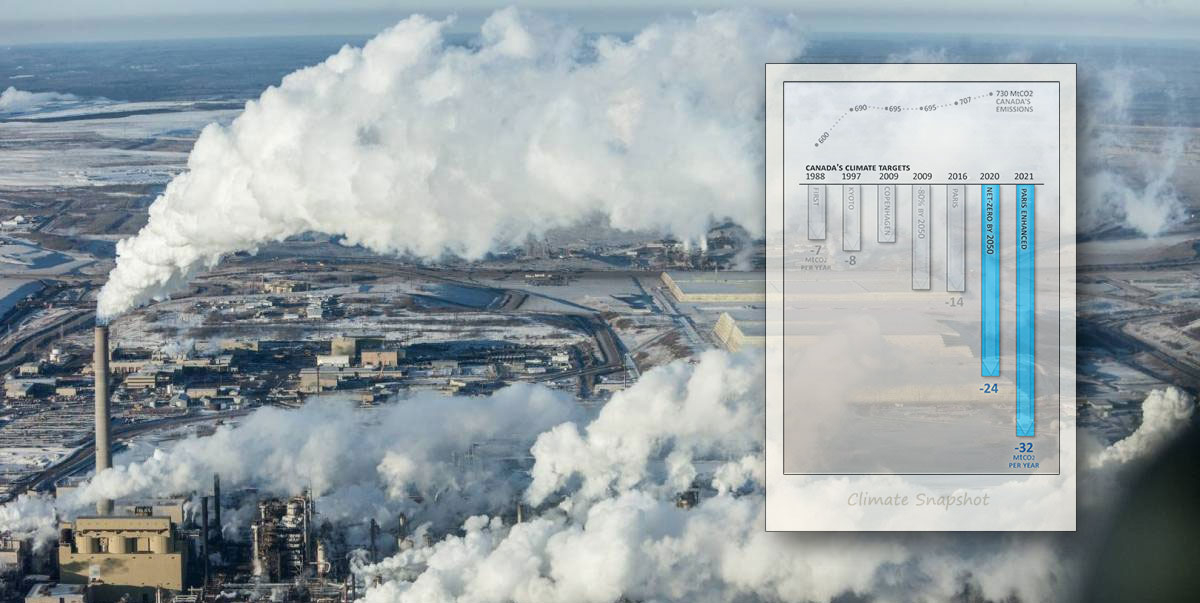



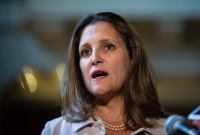
Comments
Ah, statistics - the next best thing to lies.
If you divide the total emissions of CO2 by the total population of Canada, you get a declining curve: The ratios look like this:
1988: 28.2;
2008: 21.05;
2022: 19.89
- that looks to me like Canadians are doing their part here:
More maths: 28-19/28 = 32% decrease - WOW, that's a nice number, eh? Maybe the glass is half full?
1) Cherry-picking?
Alan Ball's starting point is 1988. Choose a starting point just two years later in 1990. In that interval (1990-2019), Canada's per capita emissions remain unchanged.
In fact, Canada's per capita emissions are about the same as they were in 1970.
"CO2 emissions (metric tons per capita) – Canada"
https://data.worldbank.org/indicator/EN.ATM.CO2E.PC?view=chart&location…
2) The post-industrialized West has outsourced much of its manufacturing and emissions to the developing world, mainly SE Asia, including China.
Most rich Western nations show a decline in per capita emissions. But their declines are far steeper than Canada's.
"CO2 emissions (metric tons per capita)"
https://data.worldbank.org/indicator/EN.ATM.CO2E.PC?view=chart
3) As Environment Canada acknowledges, Canadians still rank among the highest per capita emitters. If people around the world followed our example, global emissions would skyrocket.
"Canada accounted for approximately 1.5% of global GHG emissions in 2017 (Climate Watch, 2020), although it is one of the highest per capita emitters."
Greenhouse gas sources and sinks: executive summary 2021
https://www.canada.ca/en/environment-climate-change/services/climate-ch…
4) Per capita emissions tell us who the worst offenders are. But the planet does not care about per capita emissions. The atmosphere responds to total emissions.
Canada's total nominal emissions in 2019 were the same as they were in 2000 — two decades ago.
5) Canada grossly under-reports its O&G emissions.
Are Canadians "doing their part"?
If we remain among the highest per capita emitters, I think not.
"Canada leads G20 in financing fossil fuels, lags in renewables funding, report says" (CP, Oct 28, 2021)
https://www.cbc.ca/news/science/oil-change-subsidies-1.6228679
"Canada among G20 countries least likely to hit emissions targets" (CP, Nov 11, 2019)
"Canada's buildings, transportation emissions are far above G20 average, Climate Transparency finds"
https://www.cbc.ca/news/science/canada-climate-action-1.5355517
"Canada has had nine climate plans since 1990 and has failed to hit any of the targets in them. Federal Environment and Sustainable Development Commissioner Jerry V. DeMarco said Canada has been the worst performer among G7 nations on climate targets since the landmark Paris Agreement was adopted in 2015."
"After years of missed targets, Liberals table their climate plan this week"
https://www.cbc.ca/news/politics/climate-change-canada-emissions-1.6397…
The emissions intensity of Canada's buildings, transportation, and agriculture are all well above the G20 average.
Canada produces almost 3x more GHG per capita than the average bloc member.
"Canada among worst offenders as world falls short of climate-change targets" (CBC)
• www.cbc.ca/news/thenational/national-today-newsletter-climate-change-tw…
*
Canadians produce more GHG emissions per person than any other G20 economy (Climate Transparency 2018 rpt based on 2016 numbers).
Canada is the 38th country in the world by population, has the 11th largest economy, and is the seventh biggest emitter.
On average, each Canadian produces 22 tonnes of GHG per year —the highest among all G20 members and nearly 3x the G20 average of 8 tonnes per person.
"Canada produces more greenhouse gas emissions than any other G20 country, new report says" (Toronto Star, 2018)
• www.thestar.com/news/canada/2018/11/14/canada-produces-most-greenhouse-…
*
Many Canadians drive everywhere they go in single-passenger vehicles in sprawled cities. Idle at drive-thrus. Live far from work and school. Long commutes in bumper-to-bumper traffic. Lights and computers are left on in office towers and homes. Living in big houses stuffed with things they don't need. Shop till they drop. Single-use disposables. Fly around the world for vacations. Holiday in huge RVs. Eat a heavy meat diet. Throw out 40% of their food.
*
Canada has the worst vehicle fuel economy in the world. Canada's vehicles have the highest average fuel consumption and CO2 emissions per km driven (IEA). Canada's vehicles are also the largest and the second heaviest in the world.
Canadians produce more garbage per capita than 16 other OECD nations.
Canada is one of the biggest food wasters on the planet.
*
Canada's ecological footprint is over 5 planet Earths. The average Canadian lives far beyond the planet's carrying capacity. We have a big footprint because we are energy hogs and huge resource wasters, with extravagant consumption habits. We have countless opportunities to reduce discretionary energy use and waste.
Canadians contribute disproportionately to a collective problem; we need to contribute to the collective solution.
Cherry picking? 1988 is the start point of the graph referenced by my comment.
Chronological comparisons based on percentages and absolute amounts do not take into account increased population base and the resulting increased economic activity, and changes in energy use by individuals.
Agreed that absolute amount is what counts for atmospheric physics. Misuse of statistics needs to be called out when used in polemics and news articles intended to sell a particular viewpoint (even when you agree with the viewpoint!).
According to World Bank data, Canada's per capita emissions in 2018 exceed the value in 1990. Just shift the starting point two years ahead (or back to 1970), and the decrease you pointed out disappears.
Again, most rich Western nations have shown a steeper decline in per capita emissions. Canada does not compare well on this basis.
The conclusion that "Canadians are doing their part" is not supported. We rank among the most profligate, energy- extravagant consumers on the planet.
Comparison to UK: "Back then, both nations had the same pathway to net-zero emissions in 2050 — cutting emissions 15 MtCO2 per year."
This is a spurious comparison - Canada has an energy sector which has a large hydro sector - no quick, easy CO2 savings here (especially in Saskatchewan or the Maritimes). The UK, by contrast, had a large electricity capacity based on coal. Phasing out coal fired plants in favour of North Sea gas was a profitable solution that generated and easy political win: More profits and reduced CO2 emissions. What's not to like?
If you want an genuine comparison, try Russia - it has similar geography, similar economy, similar climate and a big oil and gas business.
That's a bit myopic.
The UK's share North Sea oil & gas supply has been in decline for years. It started to peak under Thatcher who used it to finance her irrational cuts to public services, her stupid little war over some sparse islands populated mostly by sheep in the South Atlantic and to harass unions, especially unionized coal miners instead of offering retraining like a normal leader would when not drunk on ideology. Fossil fuels are kinda finite and subject to modern laws, you know. Not to mention standard Econ 101 supply and demand precepts.
Since then, coal has been mostly legislated out of the grid, a very good thing.
Wind power -- especially offshore -- has moved in to fill the energy vacuum with enormous growth potential because it's so damned cheap now.
Article: "Our existing hodgepodge of weak policies has plunged us into ever-deeper trouble."
Simple syllogism:
Major premise: Any climate plan premised on fossil fuel expansion is not merely doomed, but actually designed to fail.
Minor premise: The Liberal Govt's climate plan — conceived and designed by Corporate Canada, the Big Banks, and Big Oil — is premised on fossil fuel expansion.
Conclusion: Therefore, the Liberal Govt's climate plan is not "weak", but a deliberate, intentional, and wilful failure.
In blatant defiance of IEA and IPCC reports.
As U.N. Secretary-General Guterres puts it: "Investing in new fossil fuels infrastructure is moral and economic madness."